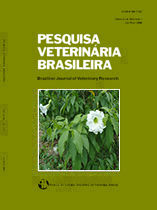 |
|
|
|
Year 2015 - Volume 35, Number 5
|

|
Molecular survey of porcine teschovirus, porcine sapelovirus, and enterovirus G in captive wild boars (Sus scrofa scrofa) of Paraná state, Brazil, 35(5):403-408
|
ABSTRACT.- Donin D.G., Leme R.A., Alfieri A.F., Alberton G.C. & Alfieri A.A. 2015. Molecular survey of porcine teschovirus, porcine sapelovirus, and enterovirus G in captive wild boars (Sus scrofa scrofa) of Paraná state, Brazil. Pesquisa Veterinária Brasileira 35(5):403-408. Laboratório de Virologia Animal, Departamento de Medicina Veterinária Preventiva, Universidade Estadual de Londrina, Rodovia Celso Garcia Cid, Campus Universitário, Cx. Postal 10011, Londrina, PR 86057-970, Brazil. E-mail: alfieri@uel.br
Porcine teschovirus (PTV), porcine sapelovirus (PSV), and enterovirus G (EV-G) are infectious agents specific to pig host species that are endemically spread worldwide. This study aimed to investigate the natural infection by these porcine enteric picornaviruses in wild boars (Sus scrofa scrofa) of Paraná state, Brazil, and to evaluate peccaries (Pecari tajacu and Tayassu pecari) as alternative host species for these viruses. Fecal samples (n=36) from asymptomatic wild boars (n=22) with ages ranging from 2 to 7 months old (young, n=14) and 2 to 4 years old (adult, n=8) and from peccaries (6 to 8 months old, n=14) were collected from a farm and a zoo, respectively, both located in Paraná state. Reverse transcription-polymerase chain reaction (RT-PCR) and nested-PCR (n-PCR) assays targeting the 5’non-translated region of the virus genome were used for screening the viruses. Porcine enteric picornaviruses were detected in 12 out of the 22 wild boar fecal samples. According to each of the viruses, EV-G was most frequently (11/22, 50%) detected, followed by PTV (10/22, 45.5%) and PSV (4/22, 18.2%). Regarding the age groups, young wild boars were more frequently (9/14, 64.3%) infected with PTV, PSV, and EV-G than adult animals (3/8, 37.4%). One n-PCR amplified product for each of the viruses was submitted to sequencing analysis and the nucleotide sequences were compared with the related viruses, which showed similarities varying from 97.7% to 100% for PTV, 92.4% to 96.2% for PSV, and 87.1% to 100% for EV-G. Peccaries tested negative for the viruses and in this study they did not represent infection reservoirs. This study is the first to report the molecular detection of PTV, PSV, and EV-G from captive wild boars in a South American country and the first to screen peccaries as alternative host species for porcine enteric picornavirus. |
| |
|
|
| |
|
 |